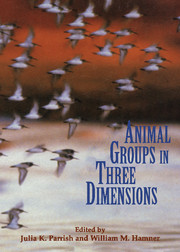Book contents
- Frontmatter
- Contents
- List of contributors
- Acknowledgments
- 1 Introduction – From individuals to aggregations: Unifying properties, global framework, and the holy grails of congregation
- Part one Imaging and measurement
- Part two Analysis
- Part three Behavioral ecology and evolution
- Part four Models
- 16 Conceptual and methodological issues in the modeling of biological aggregations
- 17 Schooling as a strategy for taxis in a noisy environment
- 18 Trail following as an adaptable mechanism for popular behavior
- 19 Metabolic models of fish school behavior – the need for quantitative observations
- 20 Social forces in animal congregations: Interactive, motivational, and sensory aspects
- References
- Subject index
- Taxonomic index
18 - Trail following as an adaptable mechanism for popular behavior
from Part four - Models
Published online by Cambridge University Press: 01 June 2010
- Frontmatter
- Contents
- List of contributors
- Acknowledgments
- 1 Introduction – From individuals to aggregations: Unifying properties, global framework, and the holy grails of congregation
- Part one Imaging and measurement
- Part two Analysis
- Part three Behavioral ecology and evolution
- Part four Models
- 16 Conceptual and methodological issues in the modeling of biological aggregations
- 17 Schooling as a strategy for taxis in a noisy environment
- 18 Trail following as an adaptable mechanism for popular behavior
- 19 Metabolic models of fish school behavior – the need for quantitative observations
- 20 Social forces in animal congregations: Interactive, motivational, and sensory aspects
- References
- Subject index
- Taxonomic index
Summary
Introduction
There are numerous examples of animal groupings (aggregations) which form as emergent patterns derived from individually based behaviors in situations where each individual has a limited knowledge of the group as a whole. This type of collective behavior occurs in fish schools, in swarms of insects and krill, as well as in large herds and flocks, and is particularly prevalent in situations where individuals have limited intelligence. To offset the lack of global knowledge, gregarious organisms have evolved individually based mechanisms for maintaining group cohesion. Other chapters have focused on mechanisms through which aggregation members communicate (see Ch. 15 by Schilt & Norris on sensory integration systems). It is also clear that less cognitive organisms must use a variety of different signals to assess their position with respect to their neighbors, if not within the group as a whole (see, for example, Ch. 14 by Dill, Holling, & Palmer, on visual and angular information). In social insects such as ants, individuals communicate and transfer information in many ways, including chemical signals and following chemical trails. This chapter presents an examination of the phenomenon of collective behavior using an example taken from the world of ants. Although many of the ideas in this chapter are written in terms of ant behavior, they apply more generally to examples from other social organisms (see Watmough & Camazine 1995 Watmough 1996).
Social insects use trail marking and following to coordinate group response. Without necessarily having a sense of the whole, individuals can form a variety of aggregation patterns by following fairly simple algorithms and relying on a limited number of sensory inputs.
Information
- Type
- Chapter
- Information
- Animal Groups in Three DimensionsHow Species Aggregate, pp. 282 - 300Publisher: Cambridge University PressPrint publication year: 1997
Accessibility standard: Unknown
Why this information is here
This section outlines the accessibility features of this content - including support for screen readers, full keyboard navigation and high-contrast display options. This may not be relevant for you.Accessibility Information
- 1
- Cited by
